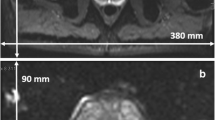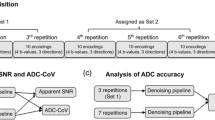Summary
This study examined the effect of different b values on diffusion-weighted MR imaging (DWI) of human prostate by using single-shot spin echo echo planar imaging (SE-EPI) sequences, observed the normal appearances and measured apparent diffusion coefficient (ADC) values in anatomical regions of normal prostate. Twenty-four healthy volunteers (mean age: 32 y) were studied by using a 1.5T system with a phased array surface multicoil. Two kinds of single-shot SE-EPI sequence were used to perform DWI in the prostate in volunteers, with five b values being 0, 30, 300, 500 to 1000 s/mm2. The image quality with different imaging parameters was analyzed and the ADC values in anatomical regions of normal prostate were measured. DWI of prostate was successfully obtained in all volunteers. The images were of good quality, without artifacts containing pixels within the prostate. The contrast was good between the different anatomical regions of the prostatic gland, i.e., the peripheral zone (PZ), which exhibited higher signal intensity, and the central gland (CG). Signal intensity contrast was related to the magnitude of b values. The ADC values in PZ and CG were (1.27±0.22)×10−3 mm2/s and (1.01±0.17)×10−3 mm2/s, respectively. The ADC values were found to be significantly higher in PZ than in CG (P<0.05, paired t-test). Significant differences were found between the slice-selecting component and both the read-out and phase-encoding components of the ADC values. It is concluded that SE-EPI is a suitable DWI sequence for human prostate. The contrast between PZ and CG is good when b values are low, while the diffusion and ADC values are accurate when b values are high. ADC values are higher in PZ than in CG in normal prostate. Diffusional anisotropy is present in normal prostatic tissue.
Similar content being viewed by others
References
Cercignani M, Horsfield M A. The physical basis of diffusion weighted MRI. J Neurol Sci, 2001,186(Suppl 1): 11–14
Sorensen A G, Wu O, Copen W A et al. Human acute cerebral ischemia: detection of change in water diffusion anisotropy by using MR imaging. Radiology, 1999,212(3): 785–792
Castillo M, Smith J K, Kwock L et al. Apparent diffusion coefficient in the evaluation of high-grade cerebral gliomas. AJNR, 2001,22(1):60–64
Mascalchi M, Filippi M, Floris R et al. Diffusion-weighted MR of the brain: methodology and clinical application. Radiol Med (Torino), 2005,109(3):155–197
Colagrande S, Carbone S F, Carusi L M et al. Magnetic resonance diffusion-weighted imaging: extraneurological applications. Radiol Med (Torino), 2006,111(3):392–419
Koh D M, Takahara T, Imai Y et al. Practical aspects of assessing tumors using clinical diffusion-weighted imaging in the body. Magn Reson Med Sci, 2007,6(4):211–224
Jemal A, Thomas A, Murray T et al. Cancer statistics, 2002. Cancer J Clin, 2002,52(1):23–47
Issa B. In vivo measurement of the apparent diffusion coefficient in normal and malignant prostatic tissues using echo-planar imaging. J Magn Reson Imaging, 2002,16(2): 196–200
Sato C, Naganawa S, Nakamura T et al. Differentiation of noncancerous tissue and cancer lesions by apparent diffusion coefficient values in transition and peripheral zones of the prostate. J Magn Reson Imaging, 2005,21(3): 258–262
Jennings D, Hatton B N, Guo J Y et al. Early response of prostate carcinoma xenografts to docetaxel chemotherapy monitored with diffusion MRI. Neoplasia, 2002,4(3): 255–262
Butts K, Daniel B L, Chen L L et al. Diffusion-weighted MRI after cryosurgery of the canine prostate. J Magn Reson Imaging, 2003,17(1):131–135
Koch M, Norris D G. An assessment of eddy current sensitivity and correction in single-shot diffusion-weighted imaging. Phys Med Biol, 2000,45(12):3821–3832
Baur A, Huber A, Wagner B E et al. Diagnostic value of increased diffusion weighting of a steady-state free precession sequence for differentiating acute benign osteoporotic fractures from pathologic vertebral compression fractures. Am J Neuroradiol, 2001,22(2):366–372
Moteki T, Horikoshi H, Oya N et al. Evaluation of hepatic lesions and hepatic parenchyma using diffusion-weighted reordered turbo FLASH magnetic resonance imaging. J Magn Reson Imaging, 2002,15(5):564–572
Yamashita Y, Tang Y, Takahashi M. Ultrafast MR imaging of the abdomen: echo planar imaging and diffusion weighted imaging. Magn Reson Imaging, 1998,8(2): 367–374
Porter D A, Calamanter F, Gadian D G et al. The effect of residual Nyquist ghost in quantitative echo planar diffusion imaging. Magn Reson Med, 1999,42(2):385–392
Naganawa S, Kawai H, Fukatsu H et al. Diffusion-weighted imaging of the liver: technical challenges and prospects for the future. Magn Reson Med Sci, 2005,4(4):175–186
Husband J E, Padhani A R, Macvicar A D et al. Magnetic resonance imaging of prostate cancer: comparison of image quality using endorectal and pelvic phased array coils. Clinical Radiology, 1998,53(9):673–681
Kim T, Murakami T, Takahashi S et al. Diffusion-weighted echoplanar MR imaging for liver disease. AJR, 1999,173(2):393–398
Allen K S, Kressel H Y, Arger P H et al. Age related changes of the prostate: evaluation by MR imaging. AJR, 1989,152(1):77–81
Lytton B. Demongraphic factors in benign prostatic hyperplasia. In: Fitzpatrick J M, Krane R J. The prostate. Edinburgh: Churchill Livingstone, 1989.85–89
Author information
Authors and Affiliations
Corresponding author
Additional information
Haojun SHI, male, born in 1973, M.D., Doctor in Charge
This project was supported by a grant from Key Project of Science and Technology Research of Hubei Province of China (No. 2005AA304B08).
Rights and permissions
About this article
Cite this article
Shi, H., Kong, X., Feng, G. et al. Diffusion-weighted single-shot echo planar MR imaging of normal human prostate using different b values. J. Huazhong Univ. Sci. Technol. [Med. Sci.] 28, 737–740 (2008). https://doi.org/10.1007/s11596-008-0628-1
Received:
Published:
Issue Date:
DOI: https://doi.org/10.1007/s11596-008-0628-1




